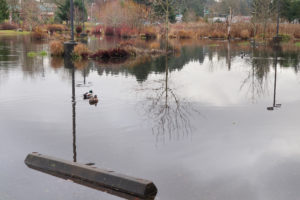 Your Mission…
Your Mission…
To find the stormwater features at the park and answer the question by listing the features you find. Hint…look for signs near the salmon poles, the signs show the stormwater features mentioned in the paragraph below.

Where can you play baseball in summer and see ducks swim in winter? Yauger Park of course! But did you know it’s also a key part of Olympia’s stormwater system? Yauger Park stores, channels, and filters stormwater runoff from 570 acres in West Olympia.
How does this happen? When it rains, water from parking lots, roads, and buildings flows into stormdrains and pipes that lead to Yauger Park. The runoff picks up all kinds of pollution along the way. Once the water reaches the park, it flows through engineered features like bioswales, weirs, and rain gardens. Then it enters the park’s pond. Stormwater ponds can work like wetlands. Allowing water to soak back into the ground to reduce flooding, while filtering out some pollutants like oil, fertilizers, bacteria, and tire particles.
As the rainy season ramps up in mid-winter, the banks of Yauger Park’s pond overflow, transforming the park’s fields and parking lots into an expansive lake. When full, the pond can hold 27 million gallons of water! It becomes a wildlife haven. Ducks flock, herons hunt, fish mingle, amphibians and beavers thrive in the flooded park. Yauger Park benefits life downstream, cleaning the water running off Olympia’s roads before reaching the Salish Sea.
PLEASE NOTE: There are 2 entrances into the park. If the gate is open, take the first entrance and park in the lot. If it is closed, you can park in the far lot.
![]()
 Welcome to the Trail
Welcome to the Trail
As you walk the trail look for each of the features listed below.
| Bioswales – Biofiltration swales are wide, ditch like channels that use grass or other dense plants to filter out sediment and oily material, or pollutants as they collect and transport stormwater. As stormwater passes through the swale, pollutants are removed by the combined effects of filtration, infiltration, and settling.
Concrete weirs – Concrete weirs are designed to slow stormwater flow and creating pools for sediment to settle to the bottom. The cobble bars below the weirs help prevent erosion from fast flowing water. Pond – This human-made pond is designed to hold and filter stormwater runoff and provide urban wildlife habitat. This pond can hold up to 27 million gallons of water! That’s enough to fill 36 Olympic swimming pools! Over time, the water is gradually released to Black Lake Meadows stormwater facility through a series of pipes and wetland channels. The water eventually flows into Black Lake Ditch to Percival Creek and out into Budd Inlet. Rain gardens – Rain gardens work like small wetlands. They catch and hold runoff from rooftops, parking lots and driveways. The plants and soil help filter harmful pollutants like oil— that run off these hard surfaces. Habitat – Native plants were planted in and around the human-made pond. These plants help filter stormwater in the pond like the raingardens and bioswales. These plants also create habitat, providing food and shelter for wildlife. The ponded water at Yauger Park hosts many wildlife species such as native birds, amphibians and insects. If you listen closely you can hear the call of the Red-winged Blackbird. |

|
![]()
 Winter Flooding of Yauger Park Yes, this is on purpose! Even with all its water-helping features, Yauger Park isn’t big enough to manage all the stormwater runoff it receives—there’s just too much impervious surface in the surrounding basin. That’s why the entire park is designed to flood. During exceptionally high rain fall events, standing water can fill the park up to its northern margins. City of Olympia crews monitor the water levels and release the excess water in a controlled manner to minimize flooding downstream.Where does stormwater come from?Anything that doesn’t allow water to pass through into the ground is referred to as an impervious surface. In the urban area, there are more impervious surface areas than there are natural areas, so without having a functioning stormwater plan, roads and urban areas can flood.Where does the excess stormwater flow?To Black Lake Meadows Reserve! Check out the Nature Sleuth game for the reserve to learn more!
Winter Flooding of Yauger Park Yes, this is on purpose! Even with all its water-helping features, Yauger Park isn’t big enough to manage all the stormwater runoff it receives—there’s just too much impervious surface in the surrounding basin. That’s why the entire park is designed to flood. During exceptionally high rain fall events, standing water can fill the park up to its northern margins. City of Olympia crews monitor the water levels and release the excess water in a controlled manner to minimize flooding downstream.Where does stormwater come from?Anything that doesn’t allow water to pass through into the ground is referred to as an impervious surface. In the urban area, there are more impervious surface areas than there are natural areas, so without having a functioning stormwater plan, roads and urban areas can flood.Where does the excess stormwater flow?To Black Lake Meadows Reserve! Check out the Nature Sleuth game for the reserve to learn more!

![]() Congratulations! You have learned all about stormwater at Yauger Park and where it goes! Be sure to send us your answers to this mission! Once your answers have been submitted, a park specific sticker will be sent to you!
Congratulations! You have learned all about stormwater at Yauger Park and where it goes! Be sure to send us your answers to this mission! Once your answers have been submitted, a park specific sticker will be sent to you!
Continue Your Mission
 Learn More About Protecting Olympia’s Water and Wildlife
Learn More About Protecting Olympia’s Water and Wildlife
What wildlife make their homes at Yauger park?
- Beavers (can you find the beaver dam in the pond?)
- Salamanders
- Herons, ducks and red-winged blackbirds
What plants do you see?
- Cattails
- Willow
- Snowberry
![]()
Learn More About Stormwater
What actions can you take to prevent stormwater pollution?
- Bag and trash your pet’s waste
- Use a commercial car wash
- Practice people and bee friendly yard care


